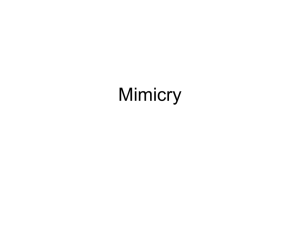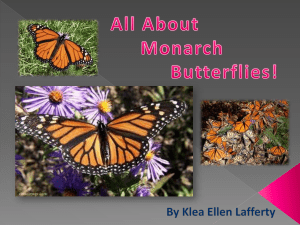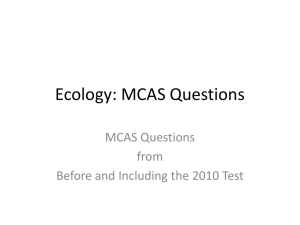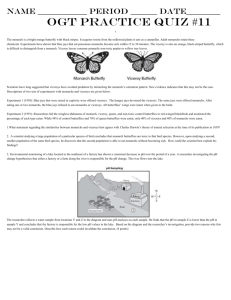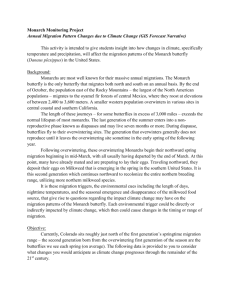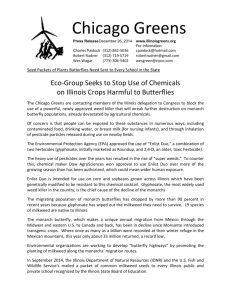Types of Natural Selection Assignment
advertisement
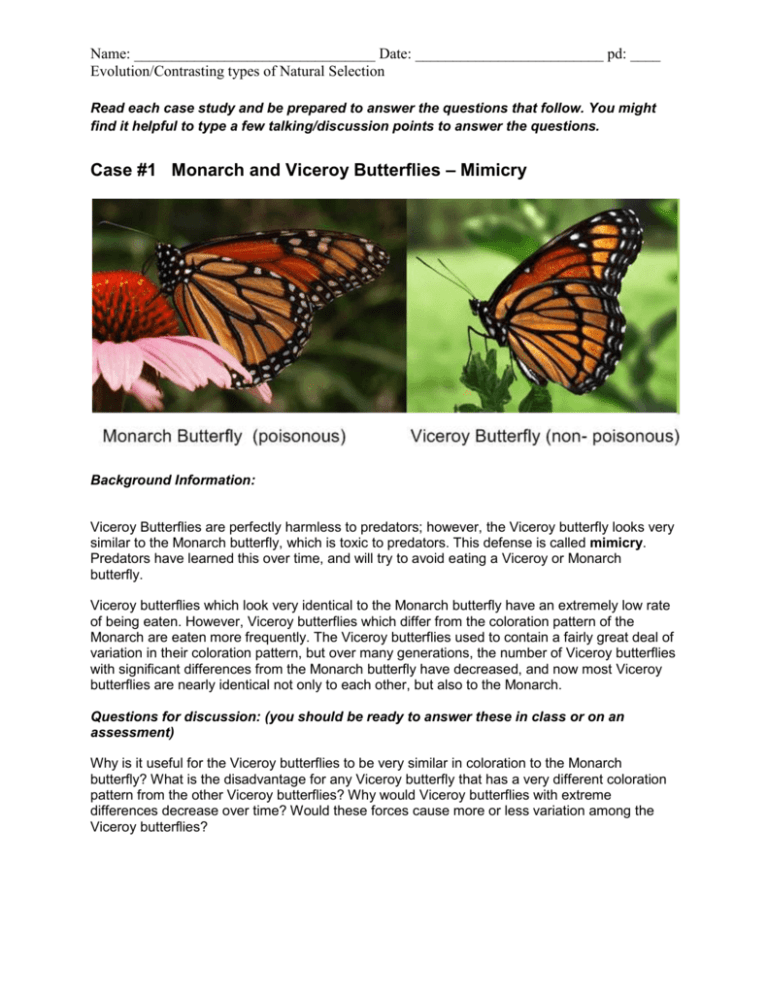
Name: ________________________________ Date: _________________________ pd: ____ Evolution/Contrasting types of Natural Selection Read each case study and be prepared to answer the questions that follow. You might find it helpful to type a few talking/discussion points to answer the questions. Case #1 Monarch and Viceroy Butterflies – Mimicry Background Information: Viceroy Butterflies are perfectly harmless to predators; however, the Viceroy butterfly looks very similar to the Monarch butterfly, which is toxic to predators. This defense is called mimicry. Predators have learned this over time, and will try to avoid eating a Viceroy or Monarch butterfly. Viceroy butterflies which look very identical to the Monarch butterfly have an extremely low rate of being eaten. However, Viceroy butterflies which differ from the coloration pattern of the Monarch are eaten more frequently. The Viceroy butterflies used to contain a fairly great deal of variation in their coloration pattern, but over many generations, the number of Viceroy butterflies with significant differences from the Monarch butterfly have decreased, and now most Viceroy butterflies are nearly identical not only to each other, but also to the Monarch. Questions for discussion: (you should be ready to answer these in class or on an assessment) Why is it useful for the Viceroy butterflies to be very similar in coloration to the Monarch butterfly? What is the disadvantage for any Viceroy butterfly that has a very different coloration pattern from the other Viceroy butterflies? Why would Viceroy butterflies with extreme differences decrease over time? Would these forces cause more or less variation among the Viceroy butterflies? Name: ________________________________ Date: _________________________ pd: ____ Evolution/Contrasting types of Natural Selection Case #2 - Melanism in the Peppered Moth Background Information: Peppered moths living in Britain prior to the Industrial Revolution were almost all light in color. The moths fly by night and rest during the day on lichen covered tree trunks (which were also a light color) where they are preyed upon by birds. A few dark (melanistic) moths were occasionally noted. During the Industrial Revolution soot began to blacken the trees. With the blackening of the trees the numbers of dark moths rapidly increased, and the number of light moths decreased to almost zero. The frequency of the dark allele increased from less than 1% to over 98% in just 50 generations. Since the 1950's, attempts to reduce industrial pollution in Britain have resulted in an increase in numbers of light form. Questions for discussion: (you should be ready to answer these in class or on an assessment) What advantage did the pre-Industrial Revolution moths gain by being light in color? Why was this trait no longer an advantage after the Industrial revolution began? What trait was then advantageous to have? Why would there have been a sudden increase in this trait and disappearance of the old one? Do these answers explain the shift in trait distribution that was seen after the Industrial Revolution? Does it also explain why the numbers of light moths are on the rebound now in Britain? Name: ________________________________ Date: _________________________ pd: ____ Evolution/Contrasting types of Natural Selection Case #3 - Bill Size in African Finches Background Information: Pyrenestes ostrinus is a seed eating finch that lives in West Africa. The species feeds on the seeds of two marsh plants, one which has hard seeds and the other which has soft seeds. Over a span of significant geologic time, the species has gone from containing a variety of bill sizes with random distribution to containing bill sizes that are either very small or very large. Most individuals fall into the extreme small or extreme large category, and studies have shown that the few unlucky birds that have intermediate size bills are rather unsuccessful at feeding and therefore do not survive as well. Questions for discussion: (you should be ready to answer these in class or on an assessment) What advantage could be obtained from having either a large or small bill in terms of feeding and survival given the finches eating habits? Why might the intermediate seized bill finches not survive as well as the others? Why would the extreme sizes increase over time? Name: ________________________________ Date: _________________________ pd: ____ Evolution/Contrasting types of Natural Selection Stabilizing Selection This is the most common type of evolution and occurs when an advantage is gained from being close to average for a given trait. Selection acts against individuals at the extreme of a phenotype. In this type of natural selection, the population will become more homogeneous and variability in traits will decrease. Graph: (shaded part is most advantageous to be in) 1. After selection acts on the above population, what will happen to the curve of the graph? 2. Which example in the introduction best fits this type of selection? 3. What is likely to be the long term outcome of this type of selection? Is speciation likely with this type of selection? If so, how many new species are likely to form? Name: ________________________________ Date: _________________________ pd: ____ Evolution/Contrasting types of Natural Selection Directional Selection This type of natural selection occurs when it is most advantageous to possess a trait which lies to one side of the average. In this type of natural selection, the population will shift towards one side of the trait distribution with variability remaining approximately the same. Graph: (shaded part is most advantageous to be in) 1. After selection acts on the above population, what will happen to the curve of the graph? 2. Which example in the introduction best fits this type of selection? 3. What is likely to be the long term outcome of this type of selection? Is speciation likely with this type of selection? If so, how many new species are likely to form? Name: ________________________________ Date: _________________________ pd: ____ Evolution/Contrasting types of Natural Selection Disruptive Selection The type of natural selection occurs when it is most advantageous to be at either end of the trait distribution, but not as advantageous to be average. This type is quite rare and leads to the population distribution taking on dual peaks centered at each end of the trait. Graph: (shaded part is most advantageous to be in) 1. After selection acts on the above population, what will happen to the curve of the graph? 2. Which example in the introduction best fits this type of selection? 3. What is likely to be the long term outcome of this type of selection? Is speciation likely with this type of selection? If so, how many new species are likely to form?
